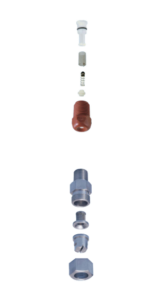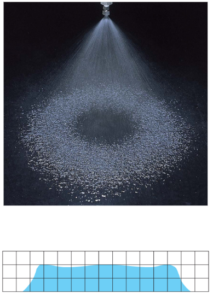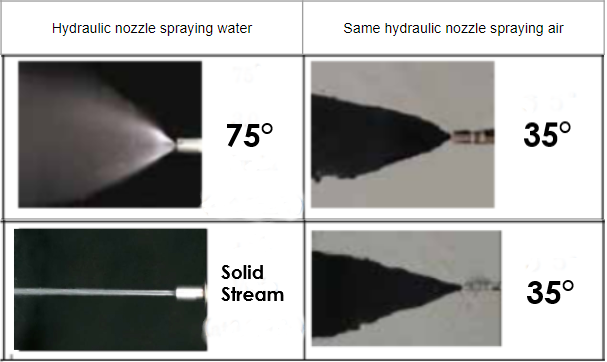December 19, 2019
Nozzles diversity

The diversity between Nozzles is very wide because each nozzle is designed for a specific purpose. One could think that nozzles are interchangeable and that they could be efficient in any situation, but nothing would be more wrong. Let’s dive into nozzles diversity and why you should never use a nozzle for something else that its original design.
First of all, there are thousands of different nozzles in our catalog (42 000) and we created each one of them for a reason: to fit one of our client’s applications.
Why is there such a large nozzle diversity?
In order to answer this question, you have to understand what differentiates one nozzle from another nozzle. There are several groups of characteristics to understand what makes a nozzle:
- its physical attributes,
- its spraying characteristics,
- and its categories within nozzles.
1) The physical attributes
- Material: First of all, nozzles can be made out of several materials. This will have a serious impact on the pressure and temperature they can handle. It will also change how the nozzle reacts to some chemicals and gases. This is a very important feature to take into account. The main materials available are plastics, stainless steel, and ceramic.
- Shape and design: Secondly, the external and internal design are what make nozzles diversity so interesting. These designs are the results of the long engineering process to produce the perfect flow of gases or liquids. This process always answers a specific need within the industrial world.
- Size: Finally, a nozzle’s size depends on the current industrial environment of your factory. When a larger flow is needed, a larger orifice will be needed for your nozzle.

2) The spraying characteristics
For all nozzles, the following characteristics are important :

- Spray angle: it is the space measured in degrees between the two edges of the spray, right at the orifice of the nozzle.
- Spray impact: this is the strength of the spray. Some applications necessitate a strong impact to be efficient.
- Spray capacity: expressed in ℓ/min or ℓ/hr, this is the volume of gas or liquid that will be sprayed by the nozzle in a given time frame.
- Spray pattern: it represents the shape of the spray. Flat spray, hollow cone, and full cone are examples of possible spray patterns. (See the top picture on the left )
Hydraulic and pneumatic nozzles have additional characteristics
- Spray distribution: this is a displayed shape of the amount of water sprayed by the nozzle. (See bottom picture on the left )
- Mean droplet diameter: this figure represents the average size of water or chemical droplets sprayed by the nozzle.
You can learn about the Fundamentals for Selecting Spray Nozzles on this page.
3) The different nozzle categories
We mainly separate our nozzles into 3 categories, depending on the fluids provided to them.
- The Hydraulic Nozzles: Hydraulic nozzles are one-fluid nozzles. Most of the time this fluid is water, but it can also spray chemicals. These nozzles are the best if you need to spray a liquid with a medium droplet diameter, a high spray capacity or a high impact. They also are prime choices for cooling, cleaning and paper trimming.
- The Pneumatic Nozzles: Pneumatic nozzles are two-fluids nozzles. This means that they spray a mix of gas and liquid. The gas, which is often compressed air, is used to break down the liquid in very small droplets. Pneumatic nozzles are best when the application requires fine spraying, really small droplets or humidification.
- The Air Nozzles: Air nozzles are used to spray gases or air. They are very useful for applications such as cooling, drying, blowing off particles, etc.
- Special Nozzles: These nozzles were designed for specific applications and can’t be classified among the other categories. The nozzle diversity is mainly due to very specific needs in the industry. Some examples of special nozzles are tank cleaners, rotating nozzles, anti-clogging nozzles, steam nozzles, etc.
Why should you not use hydraulic nozzles to spray air?
Let’s look into this with a little case study: Do NOT use hydraulic nozzles to spray air!
Our engineers wanted to test the spraying characteristics of a Hydraulic nozzle supplied with compressed air. The results would showcase if it is possible to use the same nozzle for water and air usage in an industrial application. They compared their results with those of an adequate air nozzle for the same task. They wanted to compare :
- the compressed air consumption;
- noise levels;
- the spray angle;
- the spray impact.
After running the tests, our team discovered why it is a very bad idea to use a nozzle for something else than why it is intended for.
Firstly, the compressed air consumption is way higher than the one of a technical air nozzle and is close to an open pipe.
The same goes for noise levels. When IKEUCHI’s air nozzles are designed to reduce significantly the noise levels in industrial applications (see page 11 of THIS catalog), a hydraulic nozzle used to spray compressed air will have the same noise levels as a normal pipe (considerably high levels). The consequences for the factory crew and operators of the nozzles applications can be quite detrimental.
Secondly, we should focus on actual spray performances: the spray angle and the spray impact. For every possible angle, from large to a solid stream, we observe one phenomenon: the spray angle is completely disrupted. Indeed, there is no consistency whatsoever and the angle at which the air is sprayed is not sharp and clear. This means that you would have no insurance of reaching the desired area with your air spray.
In addition to the spray angle’s inaccuracy, the spray impact is far from satisfying. The impact is much weaker, especially for compressed air and won’t be able to be satisfying for any application.

In general
You should never use a nozzle that is not a perfect fit for your application for several reasons :
- It will probably increase your productions costs (chemicals, water, compressed air consumption).
- You will lack consistency and sustainability for your production process and will then lower the quality and the quantity of your production.
- You will have little control over the settings of your nozzle.
If you want to find the perfect nozzles for your industry, contact our engineering team for tailor-made solutions!
